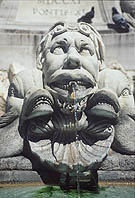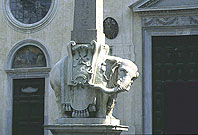Pantheon's Area
Piazza della Rotonda

Giacomo Della Porta's 16C fountain, was topped with an ancient Egyptian obelisk in the 18C.
The cafes that surround it are busy all day and far into the night as this, along with Piazza Navona, is one of Rome's major destinations for kids of all ages who come to stroll-and-stare.
Baths of Agrippa
(Terme di Agrippa, 25 BC). The earliest of the great bathing establishments of Rome was built by Agrippa as part of a complex including his original Pantheon and a lake. At his death he left it to the Roman people, for their free use. The baths, supplied with water and hot air, were adorned with frescoes and tiles.
The entire complex, including a club, a library and a restaurant burned down in 80 AD and only a few remnants have survived. The cave-like hollow at the back side of the Pantheon was attached to Agrippa's Baths, as were the circular brick excrescence that can be seen in the nearby Via dell' Arco della Ciambella, which gives an idea of the monumental proportions of what was originally a private bath for one man.
St. Maria sopra Minerva
 Some of Florence's greatest names are associated with Rome's only Gothic church: Beato Angelico, Michelangelo, Filippino Lippi and the two Medici popes.
Some of Florence's greatest names are associated with Rome's only Gothic church: Beato Angelico, Michelangelo, Filippino Lippi and the two Medici popes.
The bland, flat (as in lack of fizz) facade with its rose window is from 1453. The infamous 19C Gothic restyling can be seen inside, with the gray marble wrapping of the columns in the nave - which don't do much for Bernini's High Baroque tomb (1653) of Sister Maria Raggi, ecstasying alone and lost.
But over the centuries the interior has become an amazing museum of art treasures. Michelangelo created the statue of Christ holding his cross (1514). The modest gold cloth is definitely not the masters! And the sandal is to protect the foot from being kissed away (left of high altar).
Antoniazzo Romano painted the gilded Annunciation (1485), (fifth chapel on right). Filippino Lippi painted the masterpiece frescoes (1489), now restored to their original beauty (main wall and over the altar) in the Carafa chapel (at the end of the transept).
Its Renaissance entrance was created by Mino da Fiesole, Verrocchio and Giuliano da Maiano.
Santa Maria Sopra Minerva was the headquarters of the highly repressive Dominican order, leaders in the Inquisition. Paul IV Carafa (1555-9) the most virulent of the Inquisitor popes is buried here (Carafa chapel), as is Galileo (1564-1642), the most famous of the sages tried for heresy.
The great 15C painter Beato Angelico, a Dominican monk, is buried here (under the floor of the first chapel, left of the altar).
| St. Maria sopra Minerva History 1C AD. Under Emperor Domitian, a charming circular temple was built near here to Minerva, goddess of wisdom. |
Piazza Santa Maria sopra Minerva (Map G 5)